
01.08.2022
The origin of the world as prosthesis: provocation, claiming, closing or not
Some headlines from the last ARCO fair highlighted Wynnie Mynerva’s work as provocative, polemic, and controversial. The video, the centerpiece of their installation, shows the operation that reduced three-quarters of the opening of Mynerva’s vaginal canal, leaving only a small orifice for the evacuation of fluids. One of the news outlets announced, before it was exhibited, that “it promises to be one of the most shocking works” of the Spanish art fair. What is this promise about? Is it another clickbait? In other words, is it another hook to get views? Who is promising what and who does it shock and why? The press, as usual, promises too much: the work does not intend—in Mynerva’s words—to be provocative. Or at least not for the reasons that many expect to be scandalized (a nude or a close-up of genitalia). In this sense, the press also promises and offers little.
To understand the pieces only as provocation—without referring to the rest of their visual work and especially to their painting—runs the risk of missing the most crucial aspect of their proposal: the practice of alternative lexicons, grammars, and pragmatics of pleasure, pain, life, and death.
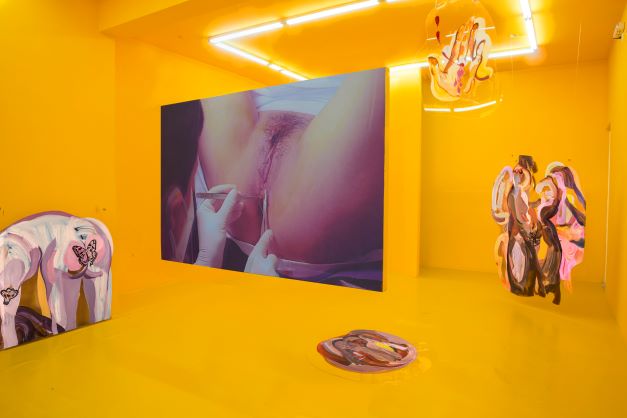
Mynerva’s work is very generous. We already knew, from the Guerrilla Girls and so many others, that to enter a museum a woman must do so naked and on a canvas painted by an artist (who is never her). But it is not just a matter of criticizing the endless colonial, racial, and sexual apparatus of painting, but of imagining a pictorial and visual language that configures bodies, sexualities, and affects in terms of greater richness and expression. This seems to be Mynerva’s objective, a project that is only a few years old and that’s worth revisiting to understand its latest work. Mynerva was born in 1993, in Villa El Salvador, a district located in southern Lima, a neighborhood they describe as violent and misogynistic. With the notable influence of Paul B. Preciado, especially the book Countersexual Manifesto (2002), they mounted their first solo exhibition El otrx sexo [The Other Sex], in 2019. In an interview, they mentioned the dildo as a starting point that allowed them to understand the dispensable character of the penis in sexuality and at the same time to discover areas of their own body. This movement is not a formula: it is not a matter of adding and subtracting body zones, but rather the organic limits of the body are destabilized by the experience of pleasure that comes from the inorganic. Following the DIY, self-guided, and dildo-proliferating style of the Countersexual Manifesto, Mynerva set out to create an inventory of erogenous zones in Peru, for which they held an opencall where they took body samples from many people. They wanted to balance certain overrepresentations of the cosmetics industry, fashion, and pornography with a collection of samples that could expand the imaginary of human variability. They began with genitalia but the repertoire quickly expanded. Through the sculptural register, the erogenous zones were able to multiply and become independent works of art.
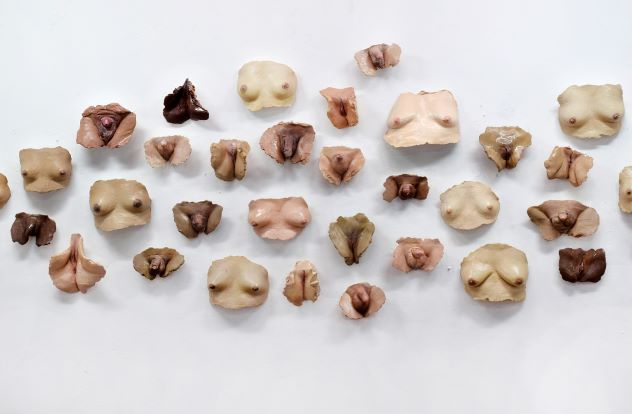
In Sex Machine, an exhibition of the same year, Mynerva continued to explore the possibilities of the body. This time, the prosthetic and plastic character of sexuality found some variations that would continue to appear in Mynerva’s work. The cross between organic and inorganic became cyborg in a more explicit way, in tones reminiscent of ero-guro, sports disciplines, steam-punk, and BDSM. The show featured an installation, sculptures (a stationary bicycle with sexual prostheses, a sex machine with a knife instead of a dildo), poems, prints, either a performance, or performances, and the large-format paintings that characterize Mynerva’s work. With a long education in art history and fine arts, painting has occupied a central place in their production from the beginning. Here the pastels and earth tones, loaded brushstrokes, sandblasted material, glazes, and displacement/juxtaposition of color planes—along with shadows and areas of black—that make their pictorial work recognizable had already appeared.
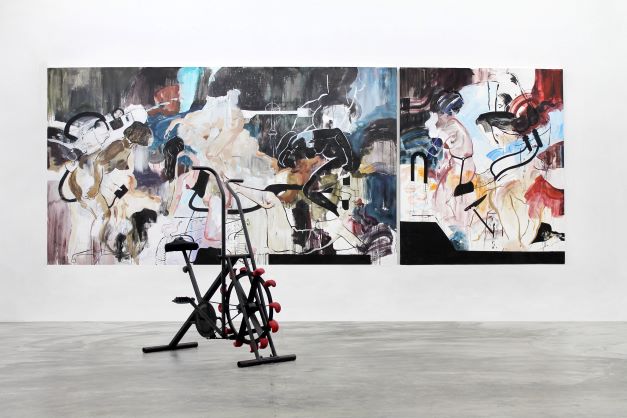
If the field of inquiry of Sex Machine was the artifactual of the body, or the corporeal of the artifact, in El jardín de las delicias [The Garden of Delights] (2020) the intersections continue but are delayed, this time, in the plant and the animal as territories of pleasure. Painting is also monumental here. This time, it is clear that the canvas acts as landscape in the installation, as a field of vision and a horizon. Intertextually with Bosch’s triptych, the exhibition proposes to re-imagine some scenes originating in the West and to diagram an alternative version of the Garden of Eden: “a great sexual landscape that draws on the sexualized plant and the animal kingdoms for the creation of a great counter-expedition narrated by the protagonists of the territories in Latin America that were previously thought of as exotic.” The green and yellow tones bring great sensuality and light to this sort of primordial uchronia. The atmosphere is not devoid of humor, since the allegorical character of the painting contrasts with the rest of the installation: the floor covered by plastic grass, as plastic as the latex bags distributed throughout the room, inside which different couples and groups were summoned to have sex. The private and the public are separated by a thin film, the intimate is established through the opacity of the Through the sculptural register the erogenous zones they were able to multiply and become independent works of art. material—which restricts to suggest— sound and movement, two planes not always central in the regimes of the visual. This iron compositional discipline contrasts with the luminosity of the panoramic painting, in which snakes, cacti, grasses, trees, and people play in the open and exuberant space of the wild. Another of the pictorial pieces in the show is a revivified version of what is generally understood as still life: the portrait of a group of tropical fruits dripping with juices and framed by a yellow figure outlined by the perimeter of Mynerva’s vulva, a polygon that refers to the inverted map of Latin America.
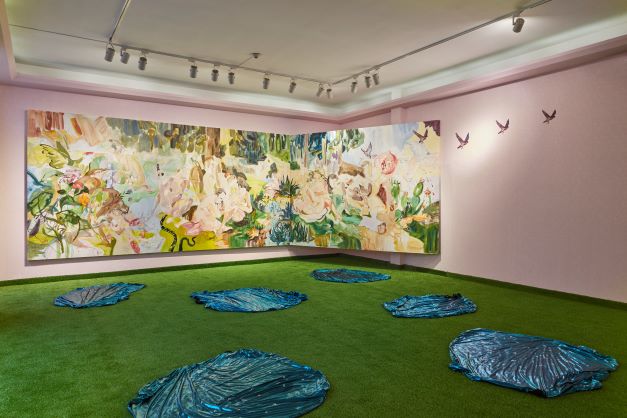
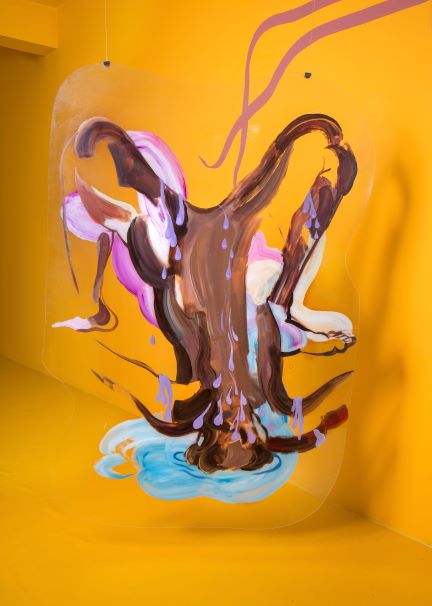
Freud wrote that the development of the normal woman depends to a large degree on the successful displacement of clitoral arousal (understood as masturbatory and infantile) to the vagina, adult territory destined for heterosexual marital exchange and baby-making. This mythology of anatomical progress may not have aged so badly: the clitoris, as a pleasure zone and (anti)reproductive organ, has been a key point of many feminist and queer sexual politics. The vagina could be another territory to reclaim, or maybe not. This possibility should not be forgotten, and therein lies the radicality of Mynerva’s gesture. The commitment to bodily reorganization is not given in terms of adequacy or coming out of the closet; rather than the revelation of an inner truth, it insists on the constructive aspect of identity, including a body with more or less organs, sectors, or contours. That is what artistic practice is about for Mynerva, freedom, testimony, and legacy. Art, “the great witness of humanity,” allows the generation of pieces containing a problem that makes whoever looks at them have no choice but to think:
“and now that I have seen it, what do I do with this?”
Comments
There are no coments available.